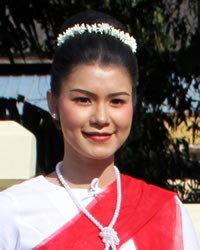Mon in Thailand

Photo Source:
Asia Harvest-Operation Myanmar
|
Send Joshua Project a map of this people group.
|
| People Name: | Mon |
| Country: | Thailand |
| 10/40 Window: | Yes |
| Population: | 123,000 |
| World Population: | 1,263,000 |
| Primary Language: | Mon |
| Primary Religion: | Ethnic Religions |
| Christian Adherents: | 0.50 % |
| Evangelicals: | 0.03 % |
| Scripture: | Complete Bible |
| Ministry Resources: | Yes |
| Jesus Film: | Yes |
| Audio Recordings: | Yes |
| People Cluster: | Mon-Khmer |
| Affinity Bloc: | Southeast Asian Peoples |
| Progress Level: |
|
Introduction / History
After moving south from China, the Mon people probably became the first inhabitants of Mainland Southeast Asia. They began the first civilizations in that part of the world. The Mon people have lived in their current location for about 1,200 years. They embraced Theravada Buddhism from Sri Lankan monks when other people groups were animistic or Hindu.
Northern Thailand is the site of the early Mon Kingdom which was founded in the sixth century. In the thirteenth century, the Thai conquered this kingdom. In the early part of the nineteenth century, the Thai forced the Mon to leave their homes and move to the Mekong River region. There were various Mon kingdoms through the centuries, but the last one was Hanthawady which ended in 1947. The Mon in Burma, now called Myanmar, were hoping to have their own independent nation when the colonial era ended. That did not happen. Today, the Mon people are mainly in Myanmar, but there is a sizable minority in Thailand.
What Are Their Lives Like?
The Mon live in village settlements from the last three or four hundred years. Their houses are like Thai homes, except that they are always situated east and west. They are rectangular, wood-framed houses raised above ground on poles. They make the walls and floors out of woven bamboo mats. They make roofs out of thatch. The wealthier Mon may live in homes with plank walls and floors. There is a verandah in front and a kitchen at the back of the house. There is a monastery in each Mon village.
Most of the Mon are small time farmers, although a few are merchants and artisans. The farmers raise fruits or vegetables. Irrigated rice is their principal crop, and they grow it for both consumption and trade. The wet rice farmers cultivate their fields with plows drawn by buffalo or oxen. They grow vegetables, sugar cane, and pineapples in home gardens. Supplementary crafts for the men include carpentry and brick making; while the women engage in pottery, weaving, and basket-making. Some men have full-time jobs as blacksmiths.
Mon families are not patrilineal (male-dominated), unless dealing with the "house spirit." This deity is in the home of the eldest living male of a lineage. The spirit's clothing and gear hang in a basket on the southeastern post of the house.
The Mon do not have formal weddings. Instead, when a boy and girl decide to marry, the boy's parents ask for the blessing of the girl's parents. The groom may move in with the bride and her family for up to three years. After that time, the couple establishes their own separate household.
Today, most Mon people dress like the Thai, so an outsider might not tell them apart.
What Are Their Beliefs?
The Mon people were the first to embrace Theravada Buddhism in Mainland Southeast Asia. Buddhist monks act as mediators between villagers and the spirits. Other practitioners include shamans (priests or priestesses), witch doctors, astrologers, and witches. The Mon people believe that witches often cause illnesses or spirit possession. The Buddhists believe that a sick person has an insufficient accumulation of merit, so their friends and family make offerings to Buddha images on his behalf. To ease the illness, shamans (mostly women) put on "spirit dances," at which time they usually become possessed by evil spirits. The doctor then seeks to exorcise the spirits by reciting chants.
They also practice their own religions, which blend spirit worship with Buddhism. Those who are traditional animists believe that good and evil spirits inhabit non-living objects. Their beliefs have been partly influenced by Hinduism, where spirits known as tewatao are associated with trees and fields. Other spirits, such as ancestral spirits, spirits that cause illness, and spirits that have magical influence, are called kalok.
What Are Their Needs?
The Mon people need the chance to put their faith in Jesus Christ rather than spirits that can only do them harm.
Prayer Points
Pray for the Lord to give the Mon people an abundant harvest this year as a testimony of his power and love.
Pray for the Mon people to have hearts that are open to the abundant blessings of Jesus Christ.
Pray for their families to prosper financially and spiritually as they experience a relationship with Jesus Christ.
Pray for a movement to Christ among the Mon that will spread joy, peace, and salvation to other peoples throughout Southeast Asia.